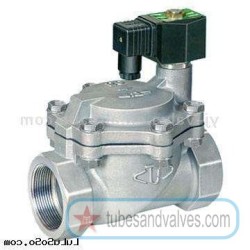Diaphragm Type Solenoid Valve
A diaphragm type solenoid valve is an electromechanical device that controls the flow of fluids and gases. It uses an electric current to drive a plunger or piston that opens or closes a valve mechanism, typically in a pipeline or a vessel. Solenoid valves can be used for both on/off and modulated control applications, as well as low-pressure, high-temperature, and hazardous conditions. They are vital components in industrial processes, HVAC systems, refrigeration systems, water filtration systems, and various other industrial applications.
The diaphragm type solenoid valve is an important type of solenoid valve, often used in applications that require handling of high temperatures, liquids and corrosive materials. Its key feature is a flexible membrane enclosed in a valve body. When the valve is energized, a plunger pushes the diaphragm against the valve seat, which seals the flow of liquid or gas through the valve.
Pros and Cons
The main benefit of using a diaphragm-type solenoid valve is that it can be used with a wide variety of fluids, including challenging materials such as water, oil, and air. The diaphragm keeps contaminants out of the valve, making it a reliable solution for controlling fluids and gases.
The downside to a diaphragm-type solenoid valve is that it can be more prone to sticking if it isn't maintained regularly. If a valve is stuck open, it can lead to the uncontrolled release of a process fluid, leading to accidents and costly repairs.
Applications
Diaphragm-type solenoid valves are widely used across a variety of industries. These include the following:
- Chemical processing
- Petrochemical
- Automotive
- Power generation and transmission
- HVAC
- Water filtration systems
- Food processing
- Pharmaceuticals
- Refrigeration systems
- Furnace manufacturing and printing
Due to their reliability, cost-efficiency, and ability to handle high temperatures, diaphragm-type solenoid valves have become the preferred choice for many applications.
Features
Diaphragm-type solenoid valves offer numerous features that make them an ideal choice for various fluid and gas control applications. Some of these features include:
- Wide temperature range capabilities
- Robust design with minimal parts for easy maintenance
- Low installation and maintenance costs
- Low pressure drop and energy consumption
- Non-lubricated operation
- Corrosion resistant body and diaphragm
- Compact size that fits in restricted spaces
- Integration with a variety of control systems
These features make diaphragm-type solenoid valves an ideal choice for many applications. For more information, consult with a professional.
Conclusion
Diaphragm-type solenoid valves are essential components for many types of industrial applications. They are robust and reliable, and can be used to control the flow of liquids and gases at varying temperatures. Their features make them an ideal choice for applications that require precise control of fluids or gases. For more information about diaphragm-type solenoid valves, contact a professional.
Diaphragm Type Solenoid Valve FAQ's
Diaphragm Type Solenoid Valve FAQ's
What is a diaphragm type solenoid valve?
A diaphragm type solenoid valve is an electromechanical device that controls the flow of fluids or gases using a flexible diaphragm that separates the valve body into two chambers.












































